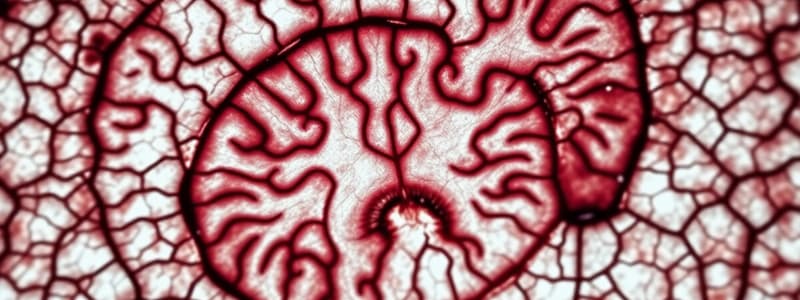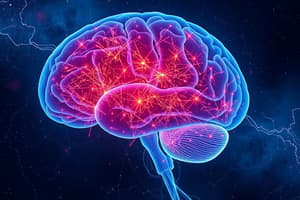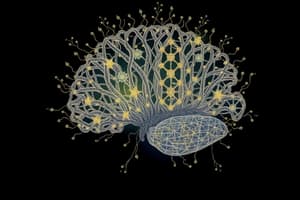Podcast
Questions and Answers
What is the primary purpose of preparing transverse hippocampal slices in this context?
What is the primary purpose of preparing transverse hippocampal slices in this context?
- To allow for analysis of field responses and excitatory field potentials (correct)
- To facilitate the recovery of brain tissue at lower temperatures
- To enable the manipulation of mossy fiber synapses
- To enhance synaptic input from CA3 pyramidal cells
Which component of the brain does NOT receive direct input from the entorhinal cortex in the tri-synaptic circuit?
Which component of the brain does NOT receive direct input from the entorhinal cortex in the tri-synaptic circuit?
- Granule cells
- CA1 pyramidal cells (correct)
- CA3 pyramidal cells
- Mossy fibers
What is the significance of cooling the brain to ~4°C during slice preparation?
What is the significance of cooling the brain to ~4°C during slice preparation?
- It enhances the excitability of the mossy fibers
- It allows for increased synaptic transmission in the CA1 area
- It improves blood flow to the hippocampal region
- It prevents enzymatic degradation during dissection (correct)
After preparation, how long are the hippocampal slices allowed to recover before recording begins?
After preparation, how long are the hippocampal slices allowed to recover before recording begins?
Field potentials are analyzed to measure which of the following phenomena?
Field potentials are analyzed to measure which of the following phenomena?
What is the function of the Schaffer collaterals in the hippocampal circuitry?
What is the function of the Schaffer collaterals in the hippocampal circuitry?
What role does artificial cerebrospinal fluid (ACSF) play in slice preparation?
What role does artificial cerebrospinal fluid (ACSF) play in slice preparation?
What effect did 0.3 µM perampanel have on AMPA receptor-mediated synaptic transmission?
What effect did 0.3 µM perampanel have on AMPA receptor-mediated synaptic transmission?
Which compound was used as a comparative drug to perampanel in the experiments?
Which compound was used as a comparative drug to perampanel in the experiments?
At what concentration did GYKI 52466 exhibit its effects in the experiments?
At what concentration did GYKI 52466 exhibit its effects in the experiments?
What was the primary measured outcome in the experiments involving perampanel and GYKI 52466?
What was the primary measured outcome in the experiments involving perampanel and GYKI 52466?
What does the term f-EPSP refer to in the context of the experimental results?
What does the term f-EPSP refer to in the context of the experimental results?
What effect does high-frequency stimulation have on the latency of population spikes?
What effect does high-frequency stimulation have on the latency of population spikes?
How does the amplitude of population spikes change with high-frequency stimulation?
How does the amplitude of population spikes change with high-frequency stimulation?
What is indicated by the early slope of f-EPSPs following the termination of AV?
What is indicated by the early slope of f-EPSPs following the termination of AV?
What happens to the amplitude of f-EPSPs as population spikes are recorded?
What happens to the amplitude of f-EPSPs as population spikes are recorded?
What trend is observed regarding the magnitudes of f-EPSPs over time?
What trend is observed regarding the magnitudes of f-EPSPs over time?
Which of the following best describes the relationship between high-frequency stimulation and synaptic distortion?
Which of the following best describes the relationship between high-frequency stimulation and synaptic distortion?
What is suggested by the reduction in latency and increase in amplitude with high-frequency stimulation?
What is suggested by the reduction in latency and increase in amplitude with high-frequency stimulation?
With a high frequency of stimulation, what characteristic of f-EPSPs is seen regarding their early slope?
With a high frequency of stimulation, what characteristic of f-EPSPs is seen regarding their early slope?
What can be inferred about the relationship between amplitude and latency in population spikes and f-EPSPs over time?
What can be inferred about the relationship between amplitude and latency in population spikes and f-EPSPs over time?
What does the term f-EPSP slope likely refer to in this context?
What does the term f-EPSP slope likely refer to in this context?
Based on the data, what effect does Perampanel at 10 µM have on the f-EPSP slope compared to baseline?
Based on the data, what effect does Perampanel at 10 µM have on the f-EPSP slope compared to baseline?
Which drug concentration is indicated as potentially effective in impacting f-EPSP slope?
Which drug concentration is indicated as potentially effective in impacting f-EPSP slope?
What might you infer about the 'No stim' condition in the experiment?
What might you infer about the 'No stim' condition in the experiment?
How long was the observed response measured in this experiment?
How long was the observed response measured in this experiment?
What annotation follows the peak response in the provided data?
What annotation follows the peak response in the provided data?
What does a higher f-EPSP slope percentage relative to baseline suggest?
What does a higher f-EPSP slope percentage relative to baseline suggest?
What concentration of Perampanel corresponds to the most significant observed decrease in f-EPSP slope?
What concentration of Perampanel corresponds to the most significant observed decrease in f-EPSP slope?
What does the amount '0.3 µM' represent in the context of the data?
What does the amount '0.3 µM' represent in the context of the data?
Which time point would logically show maximum f-EPSP activity after stimulus application?
Which time point would logically show maximum f-EPSP activity after stimulus application?
What is the primary method used to isolate and study field responses in neuronal studies, as alluded to in the content?
What is the primary method used to isolate and study field responses in neuronal studies, as alluded to in the content?
According to the content, what is the primary difference between short-term potentiation (STP) and long-term potentiation (LTP)?
According to the content, what is the primary difference between short-term potentiation (STP) and long-term potentiation (LTP)?
Based on the data provided on perampanel, what is the effect of 0.3 µM perampanel on the f-EPSP slope percentage relative to baseline?
Based on the data provided on perampanel, what is the effect of 0.3 µM perampanel on the f-EPSP slope percentage relative to baseline?
What is the likely role of the compound NBQX in the experiment shown in the data on perampanel?
What is the likely role of the compound NBQX in the experiment shown in the data on perampanel?
What is the most likely interpretation of the data point marked as CTZ (100 µM) with respect to the study of perampanel?
What is the most likely interpretation of the data point marked as CTZ (100 µM) with respect to the study of perampanel?
Which of the following best describes the principle of 'pharmacological isolation' in relation to the study of perampanel?
Which of the following best describes the principle of 'pharmacological isolation' in relation to the study of perampanel?
What is the most likely reason for the underestimation of STP magnitude and duration when using peak amplitude measurements, as mentioned in the content?
What is the most likely reason for the underestimation of STP magnitude and duration when using peak amplitude measurements, as mentioned in the content?
Given the information about underestimation of STP when using peak amplitude, which measurement technique would likely yield a more accurate representation of STP?
Given the information about underestimation of STP when using peak amplitude, which measurement technique would likely yield a more accurate representation of STP?
If the researchers wanted to investigate the potential involvement of GABA receptors in the effects of perampanel on f-EPSPs, which additional experimental approach would be most appropriate?
If the researchers wanted to investigate the potential involvement of GABA receptors in the effects of perampanel on f-EPSPs, which additional experimental approach would be most appropriate?
Based on the content, what is the most likely relationship between the methods of measurement and the accuracy of assessing both STP and LTP?
Based on the content, what is the most likely relationship between the methods of measurement and the accuracy of assessing both STP and LTP?
Flashcards
Hippocampal slice preparation
Hippocampal slice preparation
A method of studying the brain by isolating a specific area and recording its electrical activity.
The tri-synaptic circuit of the hippocampus
The tri-synaptic circuit of the hippocampus
The tri-synaptic circuit involves three main neuronal populations: the entorhinal cortex (EC), CA3 pyramidal cells, and CA1 pyramidal cells. Each population receives input from and projects to the next, forming a chain of connections.
Field EPSPs
Field EPSPs
A type of electrical signal recorded in the hippocampus that represents the summed activity of a population of neurons. They are used to study synaptic plasticity and neuronal communication.
Pharmacological isolation of excitatory field potentials
Pharmacological isolation of excitatory field potentials
Signup and view all the flashcards
Paired pulse facilitation (PPF)
Paired pulse facilitation (PPF)
Signup and view all the flashcards
Synaptic depression (SD)
Synaptic depression (SD)
Signup and view all the flashcards
Long-term potentiation (LTP)
Long-term potentiation (LTP)
Signup and view all the flashcards
Synaptic efficacy
Synaptic efficacy
Signup and view all the flashcards
Synaptic potentiation (STP)
Synaptic potentiation (STP)
Signup and view all the flashcards
Latency (of synaptic transmission)
Latency (of synaptic transmission)
Signup and view all the flashcards
Population spike (PS)
Population spike (PS)
Signup and view all the flashcards
Field excitatory postsynaptic potential (f-EPSP)
Field excitatory postsynaptic potential (f-EPSP)
Signup and view all the flashcards
Depression of f-EPSP
Depression of f-EPSP
Signup and view all the flashcards
High frequency stimulation and PS latency
High frequency stimulation and PS latency
Signup and view all the flashcards
High frequency stimulation and PS amplitude
High frequency stimulation and PS amplitude
Signup and view all the flashcards
What does perampanel do to AMPA receptors?
What does perampanel do to AMPA receptors?
Signup and view all the flashcards
What is f-EPSP slope?
What is f-EPSP slope?
Signup and view all the flashcards
How does GYKI 52466 compare to perampanel in terms of AMPA receptor inhibition?
How does GYKI 52466 compare to perampanel in terms of AMPA receptor inhibition?
Signup and view all the flashcards
What concentration of perampanel was used in the experiment?
What concentration of perampanel was used in the experiment?
Signup and view all the flashcards
What was the experimental result of perampanel on AMPA receptor activity?
What was the experimental result of perampanel on AMPA receptor activity?
Signup and view all the flashcards
Short-term potentiation (STP)
Short-term potentiation (STP)
Signup and view all the flashcards
f-EPSP slope
f-EPSP slope
Signup and view all the flashcards
NBQX (2,3-Dioxo-6-nitro-1,2,3,4-tetrahydrobenzo[f]quinoxaline-7-sulfonamide)
NBQX (2,3-Dioxo-6-nitro-1,2,3,4-tetrahydrobenzo[f]quinoxaline-7-sulfonamide)
Signup and view all the flashcards
Perampanel
Perampanel
Signup and view all the flashcards
CTZ (Clobazam)
CTZ (Clobazam)
Signup and view all the flashcards
Pharmacological isolation
Pharmacological isolation
Signup and view all the flashcards
Field responses
Field responses
Signup and view all the flashcards
Duration of synaptic response
Duration of synaptic response
Signup and view all the flashcards
Peak amplitude of f-EPSP
Peak amplitude of f-EPSP
Signup and view all the flashcards
f-EPSP (Field Excitatory Postsynaptic Potential)
f-EPSP (Field Excitatory Postsynaptic Potential)
Signup and view all the flashcards
Baseline
Baseline
Signup and view all the flashcards
AMPA Receptor
AMPA Receptor
Signup and view all the flashcards
No stim ( )
No stim ( )
Signup and view all the flashcards
Stim.
Stim.
Signup and view all the flashcards
µM (micromolar)
µM (micromolar)
Signup and view all the flashcards
CTZ (Conotoxin)
CTZ (Conotoxin)
Signup and view all the flashcards
Time (min)
Time (min)
Signup and view all the flashcards
Study Notes
Pharmacological Dissection of Field Responses
- This study focuses on pharmacological analysis of responses within the hippocampus.
- Methods used include hippocampal slice preparation.
- The study analyses excitatory field potentials within the hippocampus, focusing on precise measurements and quantification of PPF, STP, and LTP.
- The learning outcomes involve introducing hippocampal slice preparation, discussing field EPSPs (Excitatory Postsynaptic Potentials) in the CA1 area of the Schaffer collaterals and their analysis, pharmacological isolation and characterization of excitatory field potentials in the hippocampus
- Quantitative pharmacological and physiological studies using field potentials are further analyzed.
Hippocampal Slice Preparation
- Transverse hippocampal slices from rodent hippocampi (dorsal or ventral poles) are used.
- Slices are prepared in artificial cerebrospinal fluid (ACSF) at ~4°C.
- The hippocampi are dissected and transverse slices are created using a McIlwain Tissue Chopper.
- Recovery of the slices occurs at room temperature for 2 hrs before recordings begin.
The Tri-Synaptic Circuit of the Hippocampus
- The hippocampus has a well-organized tri-synaptic circuit preserved in transverse hippocampal slices.
- Granule cells receive synaptic input from the entorhinal cortex.
- They send mossy fibers to CA3 pyramidal cells which then activate the CA3 pyramidal cells.
- The axon of CA3 pyramidal cells (Schaffer collaterals) innervate CA1 pyramidal cells.
Pyramidal Cells of the Hippocampus
- Granule cell bodies, CA3 and CA1 pyramidal neurons, and their dendrites and axons are arranged in a laminar fashion.
- When stimulating Schaffer collaterals near the CA3/CA1 border, predictable biological responses are recorded in the stratum pyramidale (st.p.) and stratum radiatum (st.r.) of the CA1 area.
Current Source Density (CSD) Analysis
- Field potentials evoked by weak activation (single electric stimuli) of fibers projecting to the stratum oriens in area CA1 are recorded.
- The CSD analysis illustrates a sink in the stratum oriens and source in the cell body layer and proximal dendrites.
- Extracellular field EPSPs (Excitatory Postsynaptic Potentials) reflect intracellular events, showing a phase advance relative to the intracellular EPSPs.
Extrascellular Recording in the Hippocampal Slice
- Stratum radiatum (St.r.) responses consist of a negative presynaptic fiber volley (afferent volley), reflecting synchronized action potentials in the Schaffer collateral fibers.
- This is followed by the f-EPSP (field excitatory postsynaptic potential), whose slope is primarily mediated by AMPA receptors within the CA1 area of the St.r.).
- A positive f-EPSP is followed by a negative-going synchronized action potential discharge in CA1 pyramidal neuron bodies (population spike).
Basic Pharmacology of Evoked f-EPSPs
- f-EPSPs depend on neurotransmitter release but can be abolished by removing extracellular Ca2+.
- f-EPSPs are also dependent on ionotropic receptors; this is demonstrated using kynurenic acid (a broad-spectrum excitatory amino acid inhibitor) which abolishes f-EPSPs but preserves the afferent volley.
- Using AMPA and kainate receptor antagonist (NBQX) and sodium channel blocker (TTX) isolates the afferent volley from the fEPSP.
Paired Pulse Facilitation of f-EPSPs
- When two stimuli are applied at a short inter-pulse interval (e.g.,20-50ms), the second response (2nd f-EPSP) shows an increased slope compared to the first f-EPSP.
- This is due to increased neurotransmitter release probability.
- The ratio of slope of the 2nd EPSP to 1st EPSP (x100) can estimate paired pulse facilitation.
- An application of GABAA receptor antagonist (picrotoxin) has no effect on the early slope of f-EPSPs after termination of the fiber volley.
Short- and Long-Term Potentiation of f-EPSPs
- High-frequency stimulation (e.g., theta-burst stimulation) increases the f-EPSP slope recorded in the stratum radiatum (St.r.).
- The latency of population spikes is decreased, and their amplitude is increased with high frequency stimulation.
- Population spikes reduce the amplitude of f-EPSPs recorded in the stratum radiatum, indicating the early slope of f-EPSPs is appropriate measure of synaptic transmission.
- Short-term potentiation (STP) and long-term potentiation (LTP) measurements are less affected by measurement distortions.
Pharmacological Isolation of Field Responses
- Various experiments on pharmacological isolation of field responses demonstrate the effects of different drugs.
- These investigations examine the time course of potentiation and inhibition (e.g., by UBP145, a ketamine analogue; Ket) and the corresponding IC50 values for various substances (e.g., ketamine).
Case Story - Perampanel
- Perampanel is an AMPA receptor antagonist with an independent effect on AMPA-mediated f-EPSPs that doesn't require stimulation.
- The effects of perampanel, on AMPA receptors are unrelated to use-dependence.
- Perampanel has no effect on NMDA receptors or kainate receptor-mediated responses.
Perampanel is More Potent than GYKI 52466
- Perampanel exhibits concentration-dependent inhibition of AMPA receptor-mediated f-EPSPs.
- Perampanel shows significantly stronger inhibition compared to GYKI 52466 (IC50 values).
Perampanel has No Effect on NMDA Receptor-Mediated f-EPSPs
- Perampanel has no effect on NMDA receptor-mediated f-EPSPs, in contrast to D-AP5, an NMDA receptor antagonist.
Perampanel Has No Effect on Kainate Receptor-Mediated Responses
- Perampanel does not affect kainate receptor-mediated responses as demonstrated using NBQX and TTX blocking.
Example Questions L6
- The molecular target of AP5 is the NMDA receptor.
Studying That Suits You
Use AI to generate personalized quizzes and flashcards to suit your learning preferences.
Related Documents
Description
This quiz focuses on the key aspects of preparing transverse hippocampal slices for research purposes. It covers the significance of slice preparation techniques, circuit components involved, and the physiological processes that are measured. Test your knowledge on this essential methodology in neuroscience.




